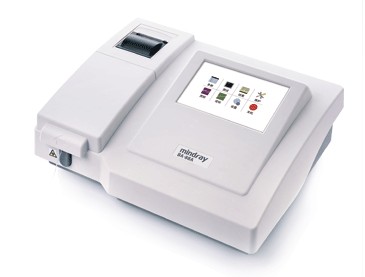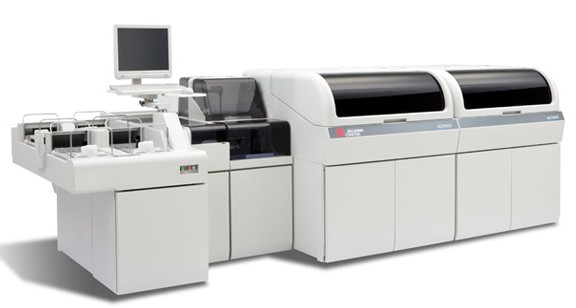1. What is biochemical test?
Biochemical testing plays an important role in medicine as well as in studying physiological and pathological changes of biochemical constants in the human body, especially contributing to the prevention, diagnosis and monitoring. treatment.
Today, with the development of applied science and technology in the field of test and diagnosis, it helps to evaluate results quickly, sensitive, accurate and quantify many low-concentration substances.
Biochemical test results are an objective factor that reflects the internal changes in the body. However, biochemical test results are also influenced by many factors due to environmental impacts, body condition: biological variability (age, gender, nutritional activity, etc.), evolution psychology, effects of treatments (drugs, infusion ...), sampling, preservation of samples, determination methods, calculation of results.
2. Operating principle
Currently, most biochemical testing machines use the optical density measurement method to determine the concentration of patient samples. You can learn this principle at the principle of photometric measurement in blood biochemical tests.
3. Structure
Some machines may have different components, but all biochemical machines have three main components:
- Light sources: These are lamps with relatively wide wavelength range, depending on the wavelength of the measurement, which one can use different types of sources.
- Dispersion unit (creating monochromatic rays - usually filters): Allows one type of wavelength to be transmitted.
- Photoelectric measuring receiver: Turns light signals into electrical signals and amplifies them (if necessary). Determine the optical density through electrical variations
The principle diagram of a basic biochemical testing machine is as follows:

4. Types of biochemical machines
a. Semi-automatic biochemical machine
The standard solutions are prepared individually, the operating procedures are controlled manually, the measurement and calculation of results are automatically carried out on multiple samples at a time.
The technician will perform the suction, brewing and tempering of the chemicals in sequence, before putting them into the suction testing machine to read the results.
Mindray semi-automatic biochemical testing machine BA-88A
b. Automatic biochemical machine
Automated standard solutions, automated controlled operating procedures, automatic measurement and calculation of results on multiple samples at once.
Chemicals are put into separate compartments of the machine, KTV samples collected, centrifuged and put into the compartment, the machine will automatically comply with the requirements from chemical phase to incubation and reading the results.
Beckman Coulter's AU-5800 high power automatic biochemical system (integrated electrolyte)
5. Use and storage
a. When real, turn off the device
- It is recommended to use a UPS to avoid sudden power outages. When the power returns, the power should be stable for 3-5 minutes to turn on the machine.
- Take care not to turn on the device immediately after turning off the device, because inductive current may damage electronic circuits. After at least 30s to
Stable new machine turned on.
- Before turning off the machine, wash many times with distilled water, cover the pump head to avoid dirt and then turn off the power.
- The device should be placed in a cool, dry place, free from moisture, dirt, preferably with a dehumidifier or air conditioner.
- Every day even if you do not use the machine should also turn on the machine 30 minutes to avoid moisture, mold
b. When getting tested
- Before starting the test, turn on the device and wait for 5-10 minutes for the device to stabilize before starting the test
- Chemicals should be removed from cabinet for 15 to 20 minutes at room temperature, stable and then used
- For tests using Endpoint method, it should incubate enough time and at the right temperature
- Avoid wiping the conical end, the suction head of the machine and the test tube with a dirty cotton or cloth. Because of this, it is easy to miss cotton, foreign objects can clog in the measuring chamber, the pump wire leads to erroneous test results.
6. Common mistakes when doing biochemical tests and remedies
a. Errors due to subjective reasons of KTV
- Suck the sample mixed with red blood cells -> Do not put the tip of the pipet too deep in the sample tube, pay attention to observe the tip of the cone.
- Mixing chemicals in the wrong ratio -> Mixing in the right proportion with the supplier, using a quality assurance pipette
- Incubation time, incubation temperature incorrect -> Should use an incubator, clock to ensure accuracy
- Smoking chemicals mixed with air bubbles -> Pay attention when using the pipette to ensure properly, the foaming chemicals should be decanted before putting into the suction tube of the machine
b. Errors due to chemicals, testing machines
- Chemical fault, expiry date -> When it is absolutely not allowed to use, other quality assurance chemicals must be used.
- The light indicator is too weak or too strong. Check the Gain ball, if it is not good quality, you need to replace it with genuine ball
- Flowcell (Curvete) is clogged up -> Remove Flowcell and use syringe to suck alcohol (or distilled water) in Flowcell to remove all foreign objects inside the tube.
- Pump is not in the right volume -> Check the pipe is not clogged. Re-check the suction pump motor of the machine.


